The Carden Loyd T13 B2 self-propelled Gun
This Belgium Army 1940 Carden Loyd T13 B2 Tank can be found at the Belgium Tank Museum in the Royal Army and Military History Museum, Jubelpark 3. Brussels. Their website is www.klm-mra.be
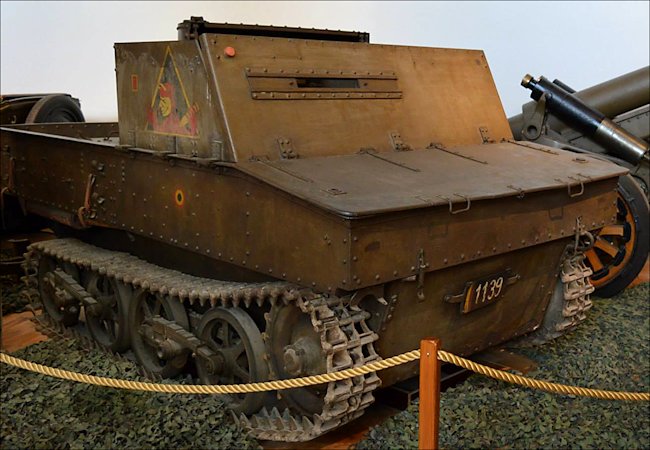
Belgium Army 1940 Carden Loyd T13 B2 SPG in the Royal Army and Military History Museum in Brussels
William has worked at the Royal Army and Military History Museum for over 35 years. This is what he said about their Carden Loyd T13 B2 self-propelled Gun:- Most if not all T13 were sent to the eastern front as radio guided mobile explosive devices and hence destroyed. Ours was found by one of our tank museum volunteers in the cellars of the Army Museum in Vienna.
After some protracted negotiations, a Belgian C130 dropping some SF troops in Bavaria, 'flew by' Vienna and loaded up our T13. When arriving at Royal Army and Military History Museum we discovered the original battery was still plugged in. Even more astonishingly it still carried it's original cammopaint and markings of the 'Limburgse Grenswielrijders' of May 1940.
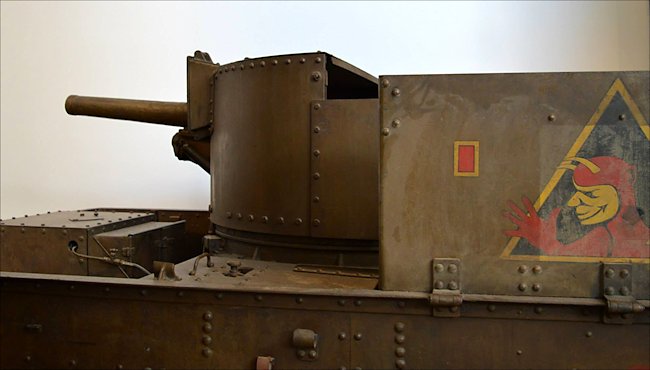
The Carden Loyd T13 B2 Tank's gun fires over the rear of the vehicle
This was a border protection regiment and when we officially presented the vehicle to the Museum, they formed up an honour guard whilst it drove by with some very poignant scenes of emotion. Yes, we made it run for a short time but since being fragile and original, it stays on static display inside the museum.
It was a pure defensive weapon, only firing to the rear, the cannon was quite good for it's time, taking on German panzers with no problems. No radio was fitted thus command and control was difficult. It mainly ambushed German columns and stayed in support of line companies. For the type of border regiment, special barracks were build like a 'Fire Brigade Station', i.e. the personnel lived on the first floor while the combat vehicles parked inside, ready to go. Quick reaction times where thus achieved, worked quite well.
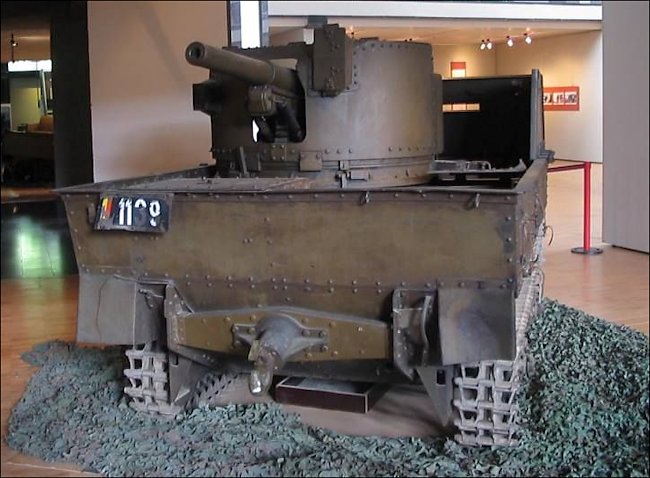
The front and side armour plates are hinged and can flap down on this Carden Loyd T13 B2 SPG
These quick reaction Belgium Army border squads were highly mechanised and equipped with of T13, side-Cars and trucks, acted as 'light-Cavalry' to slow down German progression and gaining time as shown in the photo below. The main gun fitted to the Vickers Carden-Loyd T13 B2 tank destroyer, the 47mm model 1931, was more powerful than the guns fitted to the German Panzer I and II tanks that invaded Belgium and France in May 1940.
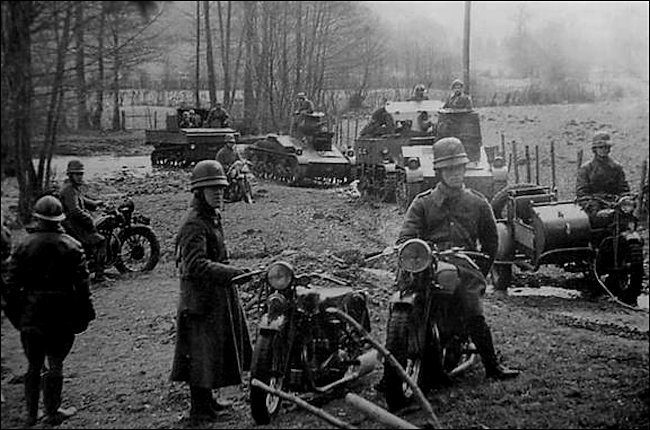
Belgium Army 1940 mechanised quick reaction border defence squads equipped with Carden Loyd Tank variants and T15 tanks.
German captured Belgium armour
When Belgium surrendered the German Army took over the surviving Belgium armoured vehicles. They were not used for front line operational service. Some were used for tank driver training, remote control bombs and others used for internal security 'policing' . The Char Leger Modele T13 B1 and T13 B2 self propelled guns were given the designation of Panzerjager (Sfl) CL 801(b). The Belgium Vickers-Carden-Loyd 4 ton Char Leger Modele T15 tank was called Panzersphwagen VCL 701(b)
Some of the turrets on captured T13's were removed and used on the Belgium section of the Atlantic wall gun enplacments.
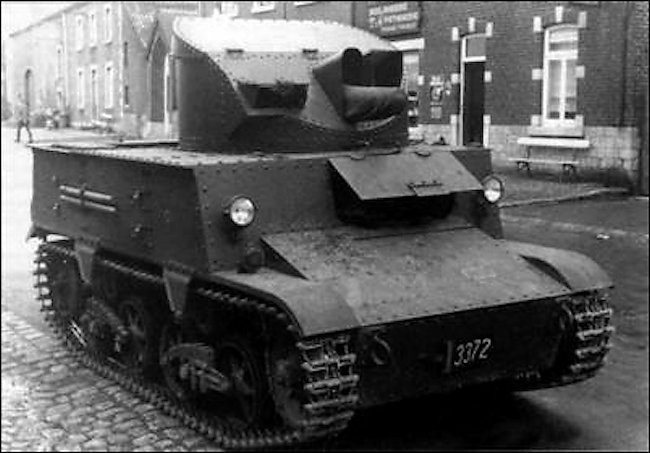
Belgium Army 1940 Carden Loyd T13 B3 Tank used the improved Vickers-Carden-Loyd Dragon Mk II B light tank chassis that could handle more weight.
Specifications
It was powered by a Meadows 5 cylinder petrol engine that produced 51 hp. It had a top road speed of 40 km/h and an operational range of around 240 km (150 miles) before the crew needed to refuel. Its armour thickness ranged from 6-12 mm. It required a 3 man crew: commander/gunner, driver, loader.
It was armed with a Belgium Royal Cannon Foundry 47 mm Model 1931 anti-tank gun (Canon anti-char de 47mm Fonderie Royale de Canons Modèle 1931, abbreviated to C.47 F.R.C. Mod.31) that outperformed similar guns of the French, German and British armies at that time. The 47mm could penetrate the armor of the German Panzer I, II and 38(t) easily. It could knock out Panzer III and Panzer IV tanks from a range of 500 metres (1,600 ft). It was also armed with a turret mounted light FN built M1918 Browning Automatic Rifle that could fire 500-650 rounds per minute in automatic mode.
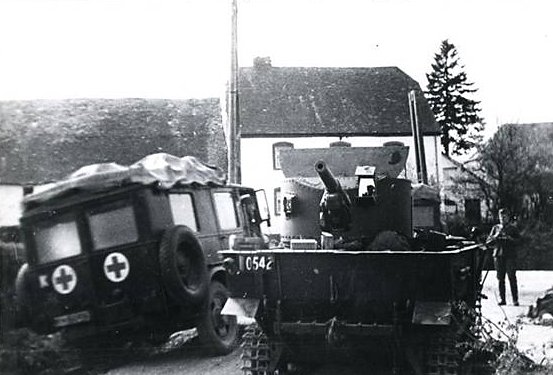
A German ambulance passing aside a knocked out Belgian T-13 B2 near Libramont May 1940
Development History of the T13 B1/B2
In 1934 the Belgium Army purchased 23 Vickers Carden Loyd model 1934 unarmed artillery tractor units to pull towed artillery guns. They worked well on hilly ground as well as flat. An order for 32 more vehicles was placed but this time a Belgium Royal Cannon Foundry 47 mm Model 1931 anti-tank gun was fitted to the back of the vehicle in an armoured turret. This became the T13 B1.
To give the gun 360° travers the side armour had to be folded down exposing the crew to injury from small arms fore or shrapnel. If the side armour shields were left up the gun had a 120° travers facing to the rear. The B2 version of the T13 only slightly differed from the B1. It had a redesigned turret to give the tank destroyer a lower front profile so the turret could hardly be seen from the front when the drivers armoured screen was up.
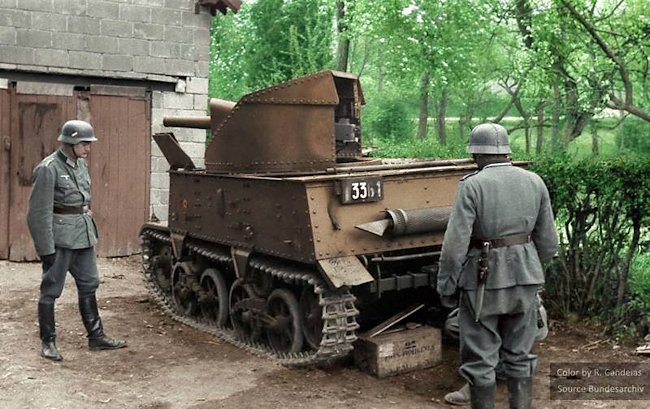
Belgian T-13 B3 tank destroyer with 47 mm Model 1931 anti-tank gun - a Vickers tracked vehicle design which was fully licensed -produced by Familleheureux. Outfitted with armament and armour by Miesse / FRC Herstal weaponry. Surviving examples were taken over by German forces in 1940. (Photo - Bundesarchiv - coloured by R Candeias)
WW2 tank books

